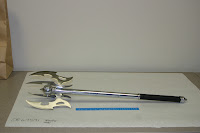Hair test backs up man's story in Box Elder
Standard-Examiner staff
Tuesday, February 15, 2011 - 10:41pm
BRIGHAM CITY -- A 57-year-old Ogden man charged in a three-county high-speed chase got something of a break in his plea bargain thanks to hair-follicle testing.
His hair apparently backed his story that he was not drunk or on drugs, just suffering from mental health issues, when he fled from police at speeds of up to 100 mph on July 20.
So the driving under the influence charge against Chris Macfarlane was reduced from a third-degree felony to a class B misdemeanor Monday in 1st District Court.
He pleaded guilty to the reduced charge as well as one count of third-degree felony evading in return for dismissal of several related misdemeanors. Judge Ben Hadfield set sentencing for March 29.
The testing proved negative as to impairment at the time of the chase, said Bernie Allen, Macfarlane's public defender. While there was some question if the test actually covered the time period of the incident, Allen said "prosecutors gave him the benefit of the doubt."
Macfarlane refused to take a Breathalyzer test at the time of his arrest so has automatically lost his driver's license under Utah law for a year. Allen said he couldn't discuss his client's mental problems, except that his thought processes at the time were "off the rails."
The advantage of hair testing is that the trace of the drugs never leaves the hair strand, unlike the blood stream, which eventually filters out controlled substances, according to officials and those involved in the testing process.
But hair testing for drugs is still fairly rare in the criminal justice system, used largely in probation situations with offenders in drug court, or in juvenile court to determine if children have been exposed to their parents' drug use.
Police say events July 20 began just before 1 p.m. as Macfarlane was driving above the speed limit northbound past Mantua Police Chief Jim Jones as Jones was clocking traffic with a radar gun.
The chase proceeded north to Wellsville in Cache County before Macfarlane turned around and headed south. The chase reached 100 mph and covered about 50 miles before he was finally stopped on Ogden's 12th Street.
Macfarlane, police said, allegedly drove southbound in the northbound lanes of I-15 for nine miles between Willard and Pleasant View at 90 mph.
Macfarlane has been held in Box Elder County Jail without bail since his arrest.
In addition to Jones, the Utah Highway Patrol, Brigham City Police Department, Perry Police Department, Weber County Sheriff's Office and Willard Police Department were involved in the chase.

